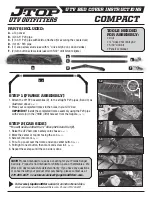
112
RADIO RECEPTION
Usually, a problem with radio reception
does not mean there is a problem with
your radio-it is just the normal result of
conditions outside the vehicle.
For example, nearby buildings and terrain
can interfere with FM reception. Power
lines or telephone wires can interfere with
AM signals. And of course, radio signals
have a limited range, and the farther you
are from a station, the weaker its signal
will be. In addition, reception conditions
change constantly as your vehicle moves.
Here are some common reception prob-
lems that probably do not indicate a prob-
lem with your radio:
FM
Fading and drifing stations—Generally,
the effective range of FM is about 40 km
(25 miles). Once outside this range, you
may notice fading and drifting, which in-
crease with the distance from the radio
transmitter. They are often accompanied
by distortion.
Multi-path—FM signals are reflective,
making it possible for two signals to reach
your antenna at the same time. If this hap-
pens, the signals will cancel each other
out, causing a momentary flutter or loss of
reception.
Static and fluttering—These occur when
signals are blocked by buildings, trees, or
other large objects. Increasing the bass
level may reduce static and fluttering.
Station swapping—If the FM signal you
are listening to is interrupted or weak-
ened, and there is another strong station
nearby on the FM band, your radio may
tune in the second station until the original
signal can be picked up again.
AM
Fading—AM broadcasts are reflected by
the upper atmosphere-especially at
night. These reflected signals can inter-
fere with those received directly from the
radio station, causing the radio station to
sound alternately strong and weak.
Station interference—When a reflected
signal and a signal received directly from
a radio station are very nearly the same
frequency, they can interfere with each
other, making it difficult to hear the broad-
cast.
Static—AM is easily affected by external
sources of electrical noise, such as high
tension power lines, lightening, or electri-
cal motors. This results in static.
CARING FOR YOUR CASSETTE PLAY-
ER AND TAPES
For high performance from your cassette
player and tapes:
Clean the tape head and other parts regu-
larly.
A dirty tape head or tape path can de-
crease sound quality and tangle your
cassette tapes. The easiest way to
clean them is by using a cleaning tape.
Use high-quality cassettes.
Low-quality cassette tapes can cause
many problems, including poor sound,
inconsistent playing speed, and
constant auto-reversing. They can
also get stuck or tangled in the cas-
sette player.
Do not use a cassette if it has been
damaged or tangled or if its label is
peeling off.
Do not leave a cassette in the player if
you are not listening to it, especially if
it is hot outside.
Store cassettes in their cases and out
of direct sunlight.
Summary of Contents for 1997 Avalon
Page 4: ......
Page 27: ...22...
Page 78: ...70 Service reminder indicators and warning buzzers...
Page 82: ...74...
Page 92: ...84...
Page 104: ...96 Button display for radio cassette tape player compact disc player Type 2...
Page 176: ...168...
Page 182: ...174...
Page 189: ...181 Canada only Fuse locations...
Page 202: ...194...
Page 211: ...203 Remove the front side marker unit Use a Phillips head screwdriver Front turn signal lights...
Page 214: ...206 High mounted stoplight type A...
Page 215: ...207 High mounted stoplight type B...
Page 216: ...208...
Page 224: ...216...
















































